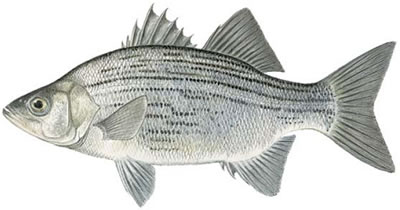A member of the temperate bass family, the white bass is a freshwater fish known for its spunky fighting ability, as well as its merits as an excellent eating fish. Because of its small size, it is often considered a panfish. White bass usually travel in schools and can provide a lot of action, making them highly desirable among light-tackle enthusiasts and for fishing with family and youths.
Identification
The white bass has a moderately deep and compressed body that is raised behind the small head and the large mouth, deepest between the two dorsal fins. It also has 11 to 13 rays on the anal fin and one to two patches of teeth at the back of the tongue. The coloration is mostly silvery with a dark grayish green on the back and anywhere from 4 to 10 dark horizontal stripes running along the sides. It also has yellow eyes, clear to dusky dorsal and caudal fins, and clear to white pectoral and pelvic fins.The white bass is sometimes confused with other members of the temperate bass family. It resembles the striped bass (M. saxatilis) by possessing the same silver sides and black stripes; it is shorter, though, than the striped bass and has a smaller head, a deeper body, a humped back, and dorsal fins that are closer together.
 |  |
The white bass is also similar in appearance to the yellow bass (M. mississippiensis) but is more silvery in color and has unbroken stripes, as well as a projecting lower jaw (in yellow bass, the jaws are about even); the white bass has separate spiny and soft portions of the dorsal fins, whereas those of the yellow bass are joined at the base.
The white bass also thrives in some waters inhabited by white perch (M. americana), particularly in the Great Lakes and their tributaries. The white bass can be distinguished from the white perch by the lack of distinct stripes on the sides of the body of the white perch, although stripes are occasionally found on the young of that species.
Size/Age
White bass average between 1⁄2 pound and 2 pounds but may weigh as much as 3 to 4 pounds; the all-tackle world record is 6 pounds, 13 ounces. They can grow up to 17.75 inches long, averaging 10 to 12 inches, and can live at least 10 years, but few make it past age 4. Females grow faster and probably live longer than males. Cold water and a lack of shad in the north, and warm water and abundant gizzard and threadfin shad populations in the south, account for regional growth differences.Life history/Behavior
White bass migrate within freshwater rivers to spawn, specifically 40 miles or less. Two year old sexually mature males reach the spawning grounds about a month before the females do, moving into the same spawning grounds every year; they arrive sometime between February and June, depending on when the water temperature rises above 45°F.Several white bass males gather around a female in 6 to 7 feet of water and push her to the surface, where she releases eggs that are quickly fertilized. Settling on rocks and vegetation in shallow water, the tiny, adhesive eggs hatch in 45 hours at 60°F. The adult fish do not protect the eggs or the young, and as a result, very few fish survive their first year. Adults move to deeper water once they have spawned, where they swim in compact schools, often close to the surface.
